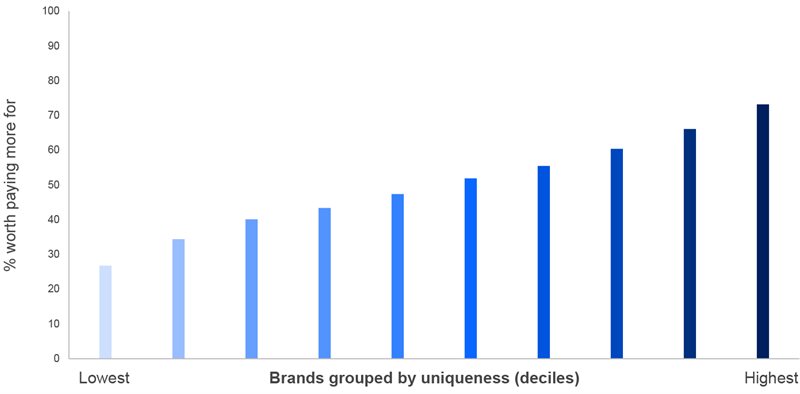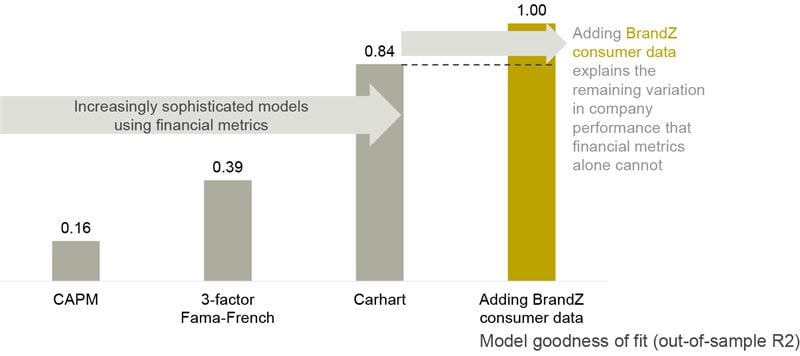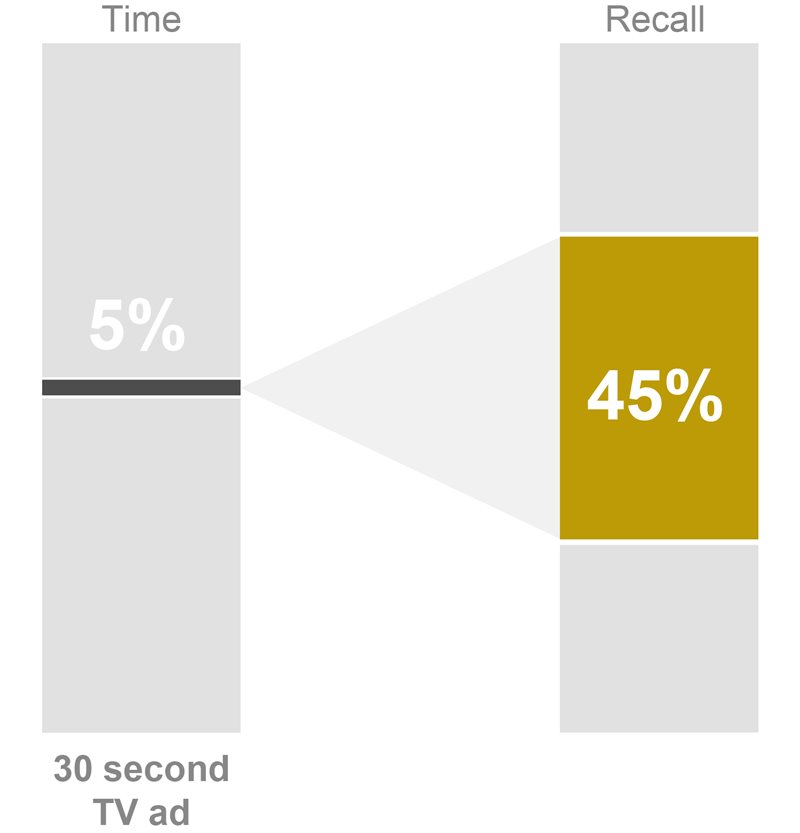Brand awareness is in every survey. Yet, despite its popularity, it’s a metric that leaves room for interpretation; it often feels like the blank nod you give to someone whose words you haven’t really heard.
Instead, asking consumers to rate a brand (and its competitors) against your chosen attributes – the ones you’ve decided to push – will signal to your brand: ‘noted’. ‘I know what you look like’, ‘get what you stand for’. Arguably, distinctiveness and knowing how to answer our clients’ frequently asked question: ‘how can I make my brand more distinctive?’, is one of the greatest challenges for brands.
In this article, we argue that ‘being different’ has legs, largely thanks to its connection to pricing power and business profit. Driven by our empirical data, we support that a distinctive brand will pivot to growth if it’s different too.
How much are consumers’ perceptions worth?
If a brand is salient, distinct and present at the category entry points – the moment a consumer enters a category – sales and growth will follow. This is what Professor Byron Sharp argues in ‘How Brands Grow’, possibly the most popular marketing book in circulation. This makes sense. One of the first rules of branding is that consumers must know it’s you. Distinctive assets are truly useful in creative work, and help brands get noticed by distracted consumers without overspending on exposure.
So, distinctiveness is branding 101. But it’s not completely removed from being different. Yes, distinctiveness is just one type of difference.
Jeremy Bullmore and Stephen King of J. Walter Thompson discuss consumers’ perceptions of brands in this treasured video from 40+ years ago and conclude that successful brands in mature categories with product parity ‘have got a distinct and very favourable personality of their own” adding that this where they think ‘the difference lies’. Differentiation is the intended brand image that you, as a marketer, hope to achieve in the mind of the consumer through positioning. Brand differentiation offers an opportunity for brands to go beyond the borders of distinctiveness, to find product-based, experience-based, even emotionally based differences that break through consumers’ expectations of parity. It’s then that a product becomes “more than a product” as Bullmore and King confer - it “begins to satisfy needs over and above purely functional needs. And if it does that, then it's worth more money”.
MarketingMary Kyriakidi,
Kantar 28 Feb 2023 Here’s the proof. We analysed 40,000 brands in our Kantar BrandZ database and found a very strong relationship between increasing relative uniqueness and a consumer’s willingness to pay more for a brand. More than boosting trial and share, achieving a differentiated brand position can lower customer price sensitivity, yield healthy margins and increase profitability.
Evidence: Difference is worth paying more for

Source: Kantar BrandZ global database
click to enlargeIf you are different, you are hard to replicate
Outdoor apparel company Patagonia has been donating 1% of its sales to “save our home planet” for the last 35+ years, Tony’s Chocolonely exists to eradicate illegal child labour and modern slavery on cocoa farms in West Africa, Nubank was founded to serve the unbanked and underbanked in Brazil, developing products for financially excluded segments since 2013. Can brand differentiation provide a moat of protection against competition, being a really hard thing to replicate in a business?
In short: yes. In 2020. Kantar partnered with the University of Oxford Saïd Business School to understand the precise contribution that different marketing activities make to “abnormal financial returns”. These are the returns that are derived when a company’s stock performs better (or worse) than the market expected. Associate Professor Felipe Thomaz and team studied 872 brands and their expected financial returns over a period of 12 years, using a series of increasingly sophisticated models from academic literature and investment analysts. They then added thousands of brand equity observations from the Kantar BrandZ database and, with an enhanced model, identified the brand factors that contribute most to those abnormal business returns.
The crown jewel finding? Difference was the biggest contributor towards abnormal stock returns.
Difference is the biggest component of equity’s power to drive abnormal stock returns

Source: University of Oxford Saïd Business School
click to enlargeBrand differentiation example
Donki (Don Quijote) “the Japanese discount store of your dreams”, offers lots of inspiration when it comes to brand differentiation. This store breaks all the rules of good retailing, but still wins because of its difference.
Donki’s brand differentiation strategy lies in the layout of its 160 stores, which is the antithesis of minimalist Japanese design; they consciously make items hard to find and hard to buy, encouraging shoppers to go on a treasure hunt. Still, consumers can’t help coming back. Kantar’s BrandZ data confirms Donki’s Difference in the way the brand is perceived compared to regular grocery stores, and this brand differentiation has helped deliver growth, with the brand now expanding across East Asia.
The secret to good branding in advertising
Distinctiveness alone in creative execution doesn’t guarantee that people will relate to what they are seeing. Brand consultant and virtual marketing professor, Mark Ritson, says that distinctiveness and differentiation have “equal weighting”, working to achieve and improve marketing effectiveness. This combination of positioning and codes is the “important dual engine for brand success”, he adds.
In this Effie-winning Snickers case study, the power of such a blend is palpable: with a campaign that reinforced mental association with ‘hunger’ and satiation that create difference for Snickers, but it also used brand codes and symbolic vocabulary to strengthen its distinctiveness. Snickers halted their declining sales and refuelled their market share.
In this year’s Kantar Creative Effectiveness Awards, Johnnie Walker’s advertising stood out and scooped awards in three categories from over 13,000 ads we tested. Famous for triggering mental associations with its rallying cry to us all to ’Keep walking’, the brand injected freshness into its heritage whilst still adhering to its distinctive branding. It was as if the brand was playfully winking to its customers: ‘I’m still me, but I am different; I now bring a fresh and timely take on life’. There was no doubt in the consumer’s mind - Johnnie Walker’s distinctive branding was recognised in every execution.
Johnnie Walker, Keep Walking Anthem
Source: Kantar Creative Effectiveness AwardsWhen branding in advertising goes wrong
The problem occurs when people don’t know what brands were advertised – more often than not they remember the ad but attribute it to the wrong brand, and only connect it to the category. The fix is not a single-minded pursuit of distinctiveness, as people still need to relate to what they are seeing.
Effective branding in advertising is not related to how early you show the brand in TV ads, nor does including the brand in the first five seconds guarantee strong brand linkage for digital (whether the ad is skipped or not). Good branding is about a well-integrated story with distinctive branding coming at the most memorable moment. It’s the result of the intelligent application of creativity that clearly connects the brand to the part of the ad that people will effortlessly remember to the pinnacle of emotional engagement of the film.
5% of the ad length creates 45% of recall

Source: Kantar Link database
So, ask yourselves, can the story be retold without reference to the brand? If no, expect the sweet smell of marketing effectiveness to permeate through the boardroom.
Improve marketing effectiveness by tapping into both layers of the brain
The equal weighting between distinctiveness and differentiation to improve marketing effectiveness is further rationalised by what we know about how consumers make choices.
When faced with a decision, reflective and considered reasoning processes in our working memory are called on – a type of thinking that takes effort and is slow. For that, it’s well-established that our lazy brains seek shortcuts, drawing on automatic processes in our memory structures that lead to intuitive judgements - an easy and fast type of thinking.
For a while, it was thought that these two types of thinking were separate, independent systems. However, there is growing recognition among behavioural scientists (and certainly, us here at Kantar) that decision-making involves a more connected single system in which both types of thinking are always employed.
What does this mean for brand managers? That they need to be building different advantages to win in both types of processing. Simple, clear associations (or else distinctive branding assets: a logo, a colour, a shape, a brand character, a sound, a smell) should be used. These allow easy and fast thinking to effortlessly deliver a positive, intuitive output. But richer, deeper associations (what we can achieve with differentiation, positioning, purpose) should be employed, so that the intuitive positive output can withstand the reflective, more considered check of the brain.
Our quest to find the answer to ‘how to differentiate your brand’ isn’t new – 45 years ago, this exact subject was already featuring in Philip Kotler’s list of a marketer’s core questions. And, although we’ve moved on from the notion of having a USP and the idea of owning something – or else death would find us-, the stories of many brands have taught us that relative strength in a few attributes vs. the competition is possible, and that differentiation can exist through positioning.
The one best advantage it offers is on price sensitivity. A differentiated brand can desensitise its customers to higher prices. And just like that, you are no longer fighting against competitors on price and consumers feel that paying more for your product or service is justified - as we’ve seen in the evidence above.
This sounds good, but is this still the case when inflation is at a 30-year high and likely to hang around?
The question of distinctiveness vs differentiation is the third ‘dilemma’ we explore in our Modern Marketing Dilemmas series. Discover the meeting point between performance marketing and brand building, and the role that mental and physical availability play in a consumer’s brand choice, in the first two articles. Get in touch to discuss how to make your brand more different, more distinct and how codes and positioning should shine through your creative execution.
Want more? Download Modern Marketing Dilemmas, Kantar’s evidence-based guide to help marketers protect their margins.
In this bold, thought-provoking and evidence-based guide, we provide solutions to the day-to-day challenges marketers face to help them protect their margins.
In each of the seven chapters, we present actionable tips to help you strengthen your brand’s intangible perceptions in the mind of consumers – what ultimately gets your brand chosen and brings tangible value to your shareholders.
We embrace opposing perspectives throughout, and by conducting in-depth empirical investigation and applying the latest advances in neuroscience, we help you move beyond table stakes.
Download this complimentary guide and discover:
- Where does performance marketing meet brand building?
- What role does brand play in the consumer decision journey?
- Is brand differentiation an effective way to reduce customer price sensitivity?
- How should your brand react when prices are going up?
- How can you prove marketing adds value to your brand?
- How should marketers stand up to recession?
- Is it still ok to talk about brand loyalty?
For the last 20 years, Kantar has been advocating and validating that brands should be meaningfully different. Get in touch if you are looking for evidence to support your business case or if you are at a decision-making crossroad. We would love to share more of our findings and talk further.
This article was first published on Kantar.com: https://www.kantar.com/inspiration/brands/is-brand-differentiation-an-effective-way-to-reduce-customer-price-sensitivity
